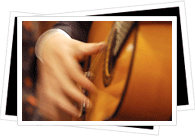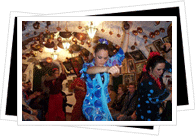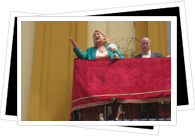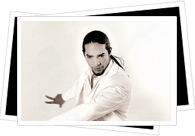 History of Flamenco
History of Flamenco
Flamenco, now an international sensation, ironically hails from Spain's historically marginal cultures. Both the music and the dance are the results of centuries of absorbing, combining, melding and finally tweaking the elements of native Andalucían, Islamic, Sephardic, and gypsy cultures. It's also widely believed, due to the strong presence of the slave trade on the Iberian peninsula, that sub-Saharan African cultures also play heavily into flamenco.
During its early years, flamenco existed as an isolated but thriving subculture, flying well below Spain's cultural radar. In Granada, for example, flamenco was developed and performed in the gypsy caves of Sacromonte- in fact, you can still head there for flamenco shows! While there aren't concrete dates about flamenco's development until the 18th century, the mysterious music and dance began to show up in literature as far back as the 16th century.
 Little by little, flamenco began to emerge as the sensational phenomenon it is. Special bars called "cafés cantantes" (singing bars) featuring flamenco singers and guitarists brought flamenco out of the caves and into the public realm. It was, however, when flamenco dancers entered the scene that the art really started to spark international attraction. Nowadays, in a strange turn of events, flamenco- created and perfected by Spain's persecuted population- is widely believed to be a quintessential part of genuine Spanish culture.
Little by little, flamenco began to emerge as the sensational phenomenon it is. Special bars called "cafés cantantes" (singing bars) featuring flamenco singers and guitarists brought flamenco out of the caves and into the public realm. It was, however, when flamenco dancers entered the scene that the art really started to spark international attraction. Nowadays, in a strange turn of events, flamenco- created and perfected by Spain's persecuted population- is widely believed to be a quintessential part of genuine Spanish culture.
Flamenco Music
While many are drawn more to flamenco's dancing element than to its music, it was the latter that first developed. The core of flamenco is the singer, or "cantaor," who belts out a heart-wrenching song of lament and strife- so passionate, at times, that his face appears to twist in pain. The next element to make an appearance was the accompanying guitar.
Watching the skillful, agile hands of a flamenco guitarist, or "tocaor," is quite the experience as he strums and plucks the 6-stringed instrument with his fingers and simultaneously taps on the wooden base to provide percussion. These two figures, the "cantaor" and the "tocaor," constantly work off each other in this stunning musical display. Finally, you're likely to see a group of people sitting beside the "tocaor." Known as "el jaleo," it consists of several people who clap their hands, stomp their feet, snap their fingers, and shout out to the dancer or to the guitarist.
Flamenco also manifests itself in other ways. During Granada's Corpus Christi and Cruces de Mayo festivals you're likely to hear "sevillanas" as well as see the accompanying sevillana dancing. Sevillanas are four-part songs and dances with a happy and festive tone that Andalucíans use to show their enthusiasm during happy times.
 During another festival, Semana Santa (Holy Week), you may be lucky enough to hear a saeta. Serving as a sung prayer, a figure may appear on a balcony and spontaneously belt out a soulful ode directed at the figure of the Virgin.
During another festival, Semana Santa (Holy Week), you may be lucky enough to hear a saeta. Serving as a sung prayer, a figure may appear on a balcony and spontaneously belt out a soulful ode directed at the figure of the Virgin.
Flamenco Dance
The third, and certainly most visually stimulated, part of flamenco is of course the whirl of color and passion that is flamenco dancing. Interestingly enough, there is no single flamenco dance- there are over 50 "palos" (types), each of which has variations due to the individual dancer's personal style.
 The role of the flamenco dancer is essentially to interpret the words of the "cantaor" with graceful arm movements that dramatically contrast the reverberating steps as they drill their heels into the floorboards. In all elements of flamenco there is a great deal of personal improvisation- flamenco dance, for example, is meant to be the spontaneous expression of the dancer at each given moment of the song. However, his or her performance must adhere to the music's traditions and rhythmic patterns.
The role of the flamenco dancer is essentially to interpret the words of the "cantaor" with graceful arm movements that dramatically contrast the reverberating steps as they drill their heels into the floorboards. In all elements of flamenco there is a great deal of personal improvisation- flamenco dance, for example, is meant to be the spontaneous expression of the dancer at each given moment of the song. However, his or her performance must adhere to the music's traditions and rhythmic patterns.
Some performances feature both a man and a woman in a duet, which often proves to be the most vivid flamenco performance of the night. With their eyes firmly locked upon each other, the dancers build off and push each other towards what becomes a competition of intensity, passion, and sexual tension.